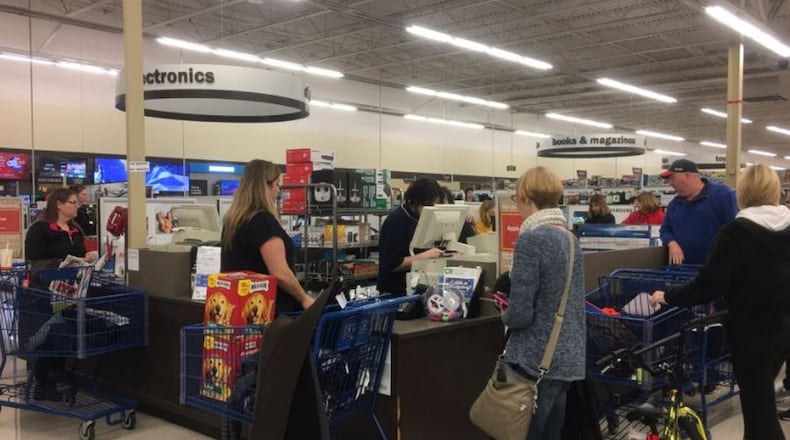Shoppers are expected to spend $6.6 billion on Cyber Monday. Approximately 78 million people in the U.S. were expected to shop on Cyber Monday, according to the National Retail Federation, due in part to changing consumer power of generations.
“As Gen Z and millennials get older, their purchasing power increases, and the rise in disposable income is sure to be seen by retailers,” said Matthew Shay, NRF president and CEO.
» RELATED: Holiday spending expected to increase in Ohio, region
Retailers pushed more sales online on Cyber Monday, but also morphed toward offering deals all week. Toys”R”Us, which filed for bankruptcy earlier this year, offered 15 percent items site-wide and another 25 percent off all Hasbro games online. Carter’s brand clothes was 60 percent off online. Elder-Beerman offered online shoppers access to an exclusive promo code for $50 off a $100 or more online purchase, and free shipping on any purchase of $25 or more
The online deals come as economists expect online sales to surpass brick-and-mortar sales this holiday season for the first time in history. About 59 percent of consumers plan to shop online this year, according to the NRF. The trade group projects that holiday retail sales in November and December this year will be up between 3.6 percent and 4 percent for a total between $678.8 billion and $682 billion. Consumers say they will spend an average $967.13 this year, according to the annual survey conducted.
Brick-and-mortar stores still saw strong sales — but they did not increase compared to last year, according to preliminary data. Shopper visits on Thanksgiving and Black Friday declined a combined 1.6 percent when compared to the same days in 2016. Black Friday 2017 shopper visits decreased less than one percent when compared to Black Friday 2016, according to preliminary data from ShopperTrak, a Tyco Retail Solutions' brand. The National Retail Federation will also release its spending data this week.
» RELATED: Travel tips: 10 worst airports to fly through for Thanksgiving travel
“There has been a significant amount of debate surrounding the shifting importance of brick-and-mortar retail, and the fact that shopper visits remained intact on Black Friday illustrates that physical retail is still highly relevant and, when done right, profitable,” said Brian Field, senior director of advisory services for ShopperTrak.
Local residents showed up in hoards on Thanksgiving evening — thousands lining up outside of JCPenney, Elder-Beerman, the Dayton Mall and the Mall at Fairfield Commons. On Black Friday, at least 600 people waited outside of Cabela’s in Centerville to land free gift cards and other prizes.
Satpal Kour of Fairborn was the first in line at JCPenney near the Dayton Mall on Thanksgiving. She waited out in the cold for more than two hours to be the first in the store to get deals on items such as outerwear and shoes.
“It’s our first time doing Black Friday, just looking for good deals,” she said.
Small Business Saturday also lured in local consumers as the day grows in popularity. Approximately 61 percent of U.S. consumers were aware of Small Business Saturday going into the day, and of those, 82 percent said they planned to shop at a small, independently-owned retailer or dine at a small, independently-owned restaurant on the day.
In Ohio, the majority of consumers spent money at restaurants, bars, pubs or supermarkets on Small Business Saturday this year, according to the Morning Consult Intelligence. About 41 percent of consumers went to a restaurant, bar or pub, and 24 percent went to a food store or supermarket. About 23 percent went to a clothing or accessories store.
“Supporting small businesses is critical to the health and livelihood of our national economy and local communities,” said NFIB CEO and President Juanita Duggan.
Looking ahead, eight of the 10 anticipated busiest shopping days still remain, including Super Saturday, which will fall on Dec. 23, according to ShopperTrak. As a potential boon to retailers, there are four Saturdays in December prior to Christmas Day, which will draw major crowds for weekend shopping.
BY THE NUMBERS
• $5 billion was spent by consumers on Black Friday in 2016
• $6.6 billion in sales expected on Cyber Monday
• 18 percent increase in sales recorded on Thanksgiving Day
Source: Adobe Analytics
FIVE FAST BUSINESS READS
• After Black Friday, small businesses try to cash in on shopping frenzy
• Overheard while Thanksgiving shopping: 'Your dad is going to kill me'
• 5 ways to stay out of debt this holiday shopping season
• Champagne gummy bears? Dorothy Lane selling new candy brand
• 17 retail horror stories that show working Black Friday is the worst
About the Author
